Exercises (3162)
Raising and lowering the legs in a hanging position ► leg raise
Power
Individual work


Hanging on the wall bars (back facing the wall bars), body stretched out, outstretched legs raised and lowered.
Attention:
Keep legs as stretched out as possible; back always remains on the wall bars, movement as controlled as possible (without momentum).
Lighten:
Lift your legs less; bend your legs.
Harden:
Additional weight for the legs.
Variation:
Cross over a painting stick with your legs alternately from one side and the other.
1 wall bars
2 weight cuffs/1 (medicine) ball (e.g. football, volleyball, basketball) ► Make the exercise more difficult (additional weight)
1 colouring stick ► Variation of the exercise
Raising and lowering the legs in supine position ► leg raise
Power
Individual work


Lie on your back, arms stretched out and held high, legs also stretched out and slightly raised, tense your stomach and raise your shoulder blades (lift your upper body slightly), raise and lower your legs.
Attention:
Do not lower your shoulders, no hollow back (pull your belly button towards your spine).
Lighten:
Just hold the position (without raising and lowering your legs).
Harden:
Additional weight on the legs (and arms).
2-4 weight cuffs/1-2 weight balls/1 weight disc/dumbbell ► Make the exercise more difficult (additional weight)
Raising and lowering the legs in supine position ► leg raise
Power
Individual work


Back position, arms stretched out in a high position, hold the pistol with both hands, legs also stretched out and slightly raised, tense your stomach and raise your shoulder blades (raise your upper body slightly), raise and lower your legs.
Attention:
Do not lower your shoulders, no hollow back (pull your belly button towards your spine).
Lighten:
Just hold the position (without raising and lowering your legs).
1 pistol (neutralised)
Raising and lowering the legs in supine position ► leg raise
Power
Individual work


Back position, legs and arms stretched out in high hold, hold assault rifle by handguard and butt parallel to the ground (barrel/piston pointing to the side), raise and lower legs.
Attention:
Do not lower shoulders and legs.
Lighten:
Hold position only (without raising and lowering legs); lower legs less; bend legs; bring arms towards forehand.
1 assault rifle (neutralised)
Raising and lowering the legs in supine position ► leg raise
Power
Individual work


Lie on your back, legs stretched and slightly raised, arms at your sides on the floor, hands on the soft mat (stability), raise and lower your legs.
Attention:
Keep your back in constant contact with the floor (no hollow back, consciously tense your stomach), do not lower your legs.
Lighten:
Lift your legs a little more and lower them less; just hold the position.
Harden:
Additional weight for the legs.
Variant I:
Lift and lower your legs alternately.
Variant II:
Bend your legs together (straight or turn to the side) and stretch.
1 soft mat (small)
2 weight cuffs/(medicine) ball ► Make the exercise more difficult (additional weight)
Raising and lowering the legs in supine position ► leg raise
Power
Individual work


Lie on your back on the vaulting box with your buttocks at the end of the box, hands grasping the other end of the box, legs stretched out in a high position, raise and lower your legs.
Attention:
Keep your legs as stretched as possible, keep your back in constant contact with the top of the vaulting box (no hollow back, consciously tense your stomach).
Lighten:
Lower your legs less.
Harden:
Additional weight for the legs.
1 vaulting box
2 weight cuffs/1 (medicine) ball (e.g. football, volleyball, basketball) ► Make the exercise more difficult (additional weight)
Raising and lowering the legs in supine position ► leg raise
Power
Individual work

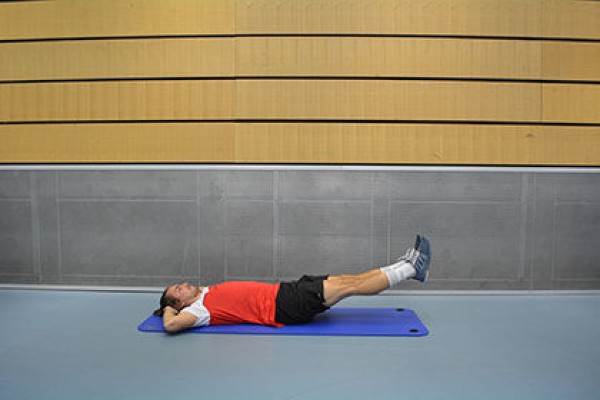
Lie on your back with your arms crossed behind your head. Raise and lower your outstretched, slightly raised legs together or move them up and down in opposite directions.
Attention:
Keep your (lower) back in constant contact with the floor (no hollow back, consciously tense your abdomen), do not put your legs down.
Lighten:
Just hold the position (legs stretched out and slightly raised off the floor).
Harden:
Additional weight for the legs (or arms held high if necessary).
Variant I:
Move your legs from the left to the right side.
Variant II:
Execute circular movements (integrate changes of direction).
Variant III:
Open your legs and bring them together again.
Variant IV:
Cross your legs alternately (open and close).
2-4 weight cuffs/1 weight ball/weight disc/dumbbell ► Make the exercise more difficult (additional weight)
Raising and lowering the legs in supine position ► lying leg raise
Power
Individual work


Lie on your back, legs stretched and slightly raised, arms at your sides on the floor (or place your hands under your buttocks / or clasp your hands behind your head), raise and lower your legs.
Attention:
Keep your (lower) back in constant contact with the floor (no hollow back, consciously tense your stomach), do not put your legs down.
Lighten:
Lift your legs slightly more and lower them less; bend your legs; just hold the position.
Harden:
Additional weight for the legs.
Variant I:
Lift and lower your legs alternately.
Variant II:
Bend your legs together (straight or turn to the side) and stretch.
2 weight cuffs/1 (medicine) ball (e.g. football, volleyball, basketball) ► Make the exercise more difficult (additional weight)
Raising and lowering the legs in supine position ► lying leg raise
Power
Individual work

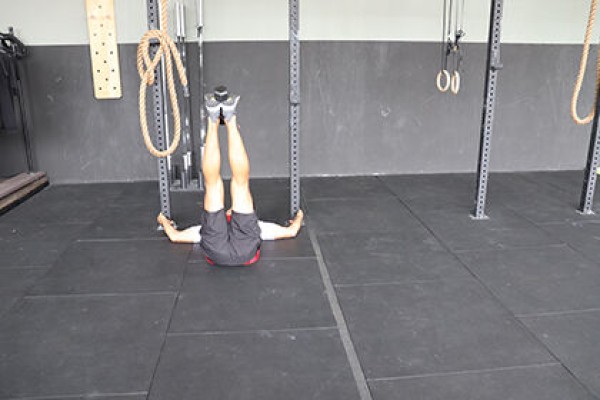
Lie on your back, legs stretched out in extension of your body and slightly raised from the floor, a dumbbell is clamped between your feet, hold on to a fixed object behind your head with your hands, arms bent (about 90 degrees at the elbow joint - upper arms pointing horizontally to the side at shoulder height, forearms pointing upwards), raise and lower your legs.
Attention:
Keep your (lower) back in constant contact with the floor (no hollow back, consciously tense your abdomen), do not lower your legs.
Lighten:
Lift your legs slightly more in the starting position and lower them less during the exercise; bend your legs; less or no additional weight.
Harden:
More weight.
1 dumbbell
Raising and lowering the legs in supine position alternately ► flutter kick
Power
Individual work
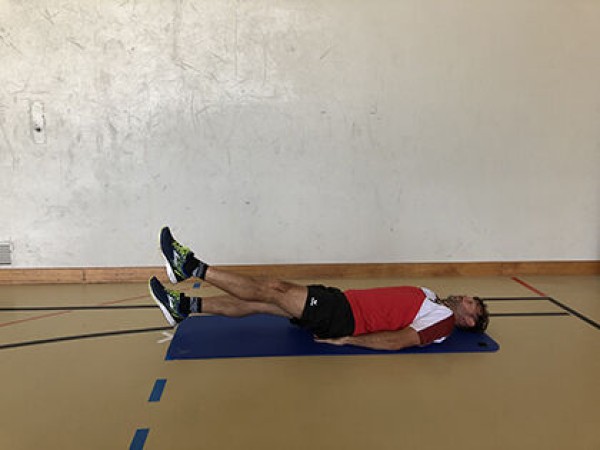

Lie on your back with your arms flat on the floor at your sides (or place your hands under your buttocks / or clasp your hands behind your head), move your outstretched, slightly raised legs up and down in constant alternation.
Attention:
Keep your (lower) back in constant contact with the floor (no hollow back, consciously tense your stomach), do not put your legs down.
Lighten:
Just hold the position (legs stretched out and slightly raised off the floor).
Harden:
Additional weight for the legs.
Variant I:
Cross or open your legs and bring them back together.
Variant II:
Make circular movements (in both directions) with your legs.
2 weight cuffs ► Make the exercise more difficult (additional weight)
Raising and lowering the legs in supine position alternately ► flutter kick
Power
Individual work
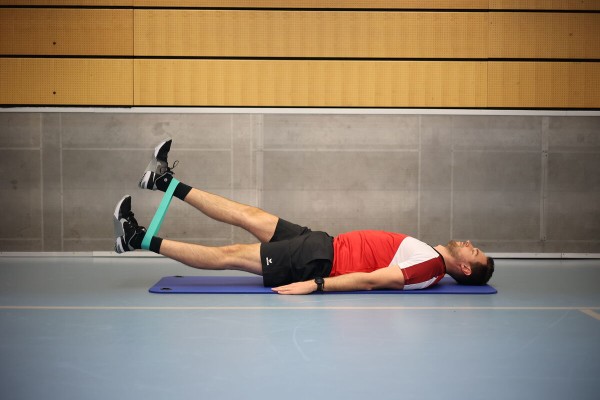
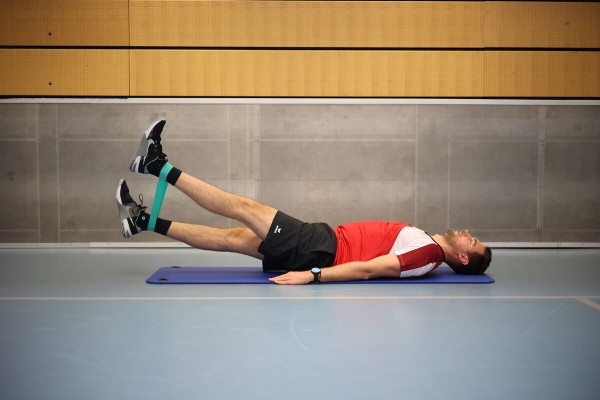
Lie on your back with your arms flat on the floor at your sides (or place your hands under your buttocks/or clasp your hands behind your head), stretch an elasticated band between your legs (place the band around your ankles) and move your slightly raised legs up and down (hip flexion/extension).
Attention:
Keep your (lower) back in constant contact with the floor (no hollow back, consciously tense your stomach), do not put your legs down.
Lighten:
Choose an elastic band with less resistance.
Harden:
Choose an elastic band with more resistance.
1 mini-band
Raising and lowering the legs in lateral position (left)
Power
Individual work


Sideways position (right), exercise ball clamped between the outstretched legs, raise and lower legs (ball)
Attention:
Head, torso, hips and knees practically form a line, do not fully lower the lower leg.
Lighten:
Support legs slightly raised in place (without lifting and lowering the legs/ball); lift and lower legs/ball less.
Harden:
Additional weight on the legs.
1 exercise ball
2 weight cuffs ► to make the exercise more difficult (additional weight)
Raising and lowering the legs in lateral position (right)
Power
Individual work

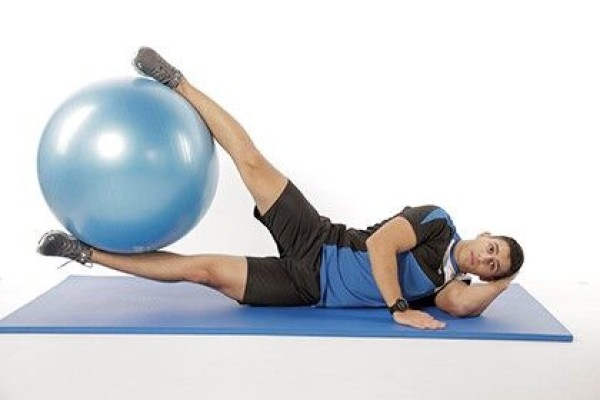
Sideways position (left), exercise ball clamped between the outstretched legs, raise and lower legs (ball)
Attention:
Head, torso, hips and knees practically form a line, do not fully lower the lower leg.
Lighten:
Support legs slightly raised in place (without lifting and lowering the legs/ball); lift and lower legs/ball less.
Harden:
Additional weight on the legs.
1 exercise ball
2 weight cuffs ► to make the exercise more difficult (additional weight)
Raising and lowering the legs and pelvis in supine position ► leg raise
Power
Individual work


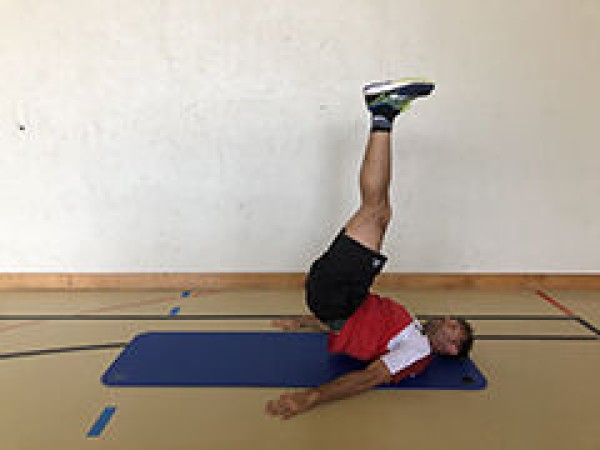
Lie on your back with your arms at your sides on the floor (or with your arms bent behind your head and your hands gripping a fixed object to ensure more stability/hold). Raise outstretched, slightly bent legs together and push out vertically upwards (release buttocks from the floor). Then lower your buttocks and lower your legs back to the starting position.
Attention:
Do not lower your legs completely.
Lighten:
Lift and lower your legs only (without pushing them vertically upwards).
Harden:
Additional weight for the legs.
2-4 weight cuffs/1 weight ball/weight disc/dumbbell ► Make the exercise more difficult (additional weight)
Raising and lowering the legs and upper body in a supine position ► leg raise crunch
Power
Individual work


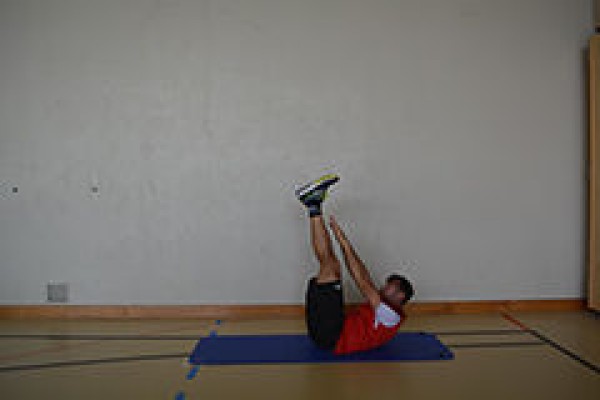
Lie on your back, legs stretched and slightly raised, arms bent and also slightly raised behind the head (or stretched out in extension of the body), in a first phase raise the almost stretched legs, at the same time bring the arms outstretched in front of the chest (holding out), in a next step raise the upper body so that the stretched arms are moved towards the feet/shins. Reverse the sequence of movements to return to the starting position (lower your upper body and legs).
Attention:
Do not lower your arms and legs completely (constant tension), keep your head in a neutral position (no double chin).
Lighten:
Lower your arms and legs completely after each exercise; only raise and lower your legs.
Harden:
Additional weight.
2 weight cuffs/1 (medicine) ball (e.g. football, volleyball, basketball) ► Make the exercise more difficult (additional weight)
Raising and lowering the elbows in a raised prone position ► rear delt raise
Power
Partner work
1 trainee & 1 helper ► Note change of position
(= double the time required; for lesson planner see Organisation Kraft: Info button Execution)
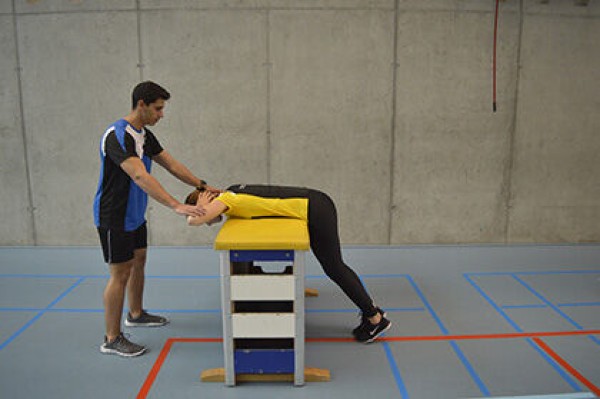
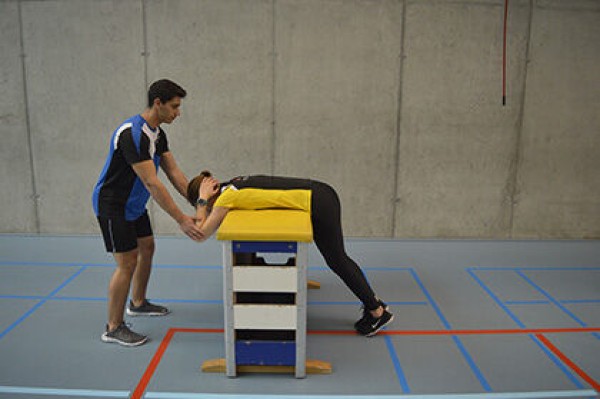
Exerciser: Standing, support your upper body on the narrow side of the vaulting box, clasp your hands behind your head (elbows pointing downwards), raise your elbows horizontally and return to the starting position.
Partner: Stands on the opposite side of the vaulting box to the active participant, holds the elbows against the movement of the exerciser (presses down).
Attention:
Always listen to/respond to your partner (adjust pressure/intensity). Elbows are at shoulder height or slightly below.
Lighten:
Less resistance from the partner.
Harden:
More resistance from the partner.
1 swing box (3-4 elements incl. top section)
Raising and lowering the heel while standing on one leg (left) ► calf raise
Power
Individual work
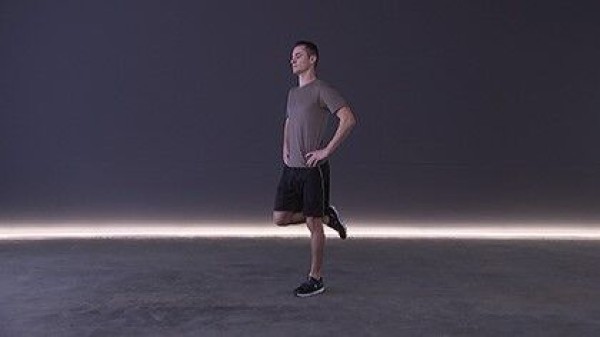

Stand upright on one leg (on the left leg), arms crossed behind the body, raise the heel (standing on the tip of the foot) and lower without fully setting down.
Attention:
Maintain an upright position (body tension), aim for a fixed point with your eyes for balance.
Lighten:
Support yourself on a wall or with a partner to keep your balance.
Harden:
Hold additional weight (on your shoulders/in front of your chest or in your hands).
1 weight vest/weight disc/barbell/sandbag/fighting backpack/2 dumbbells ► Make the exercise more difficult (additional weight)
Raising and lowering the heel while standing on one leg (left) ► calf raise
Power
Individual work
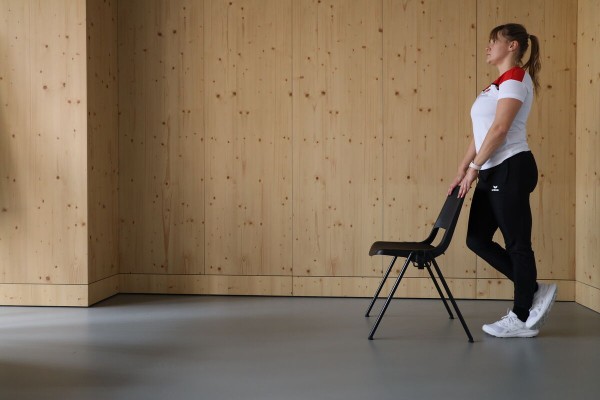
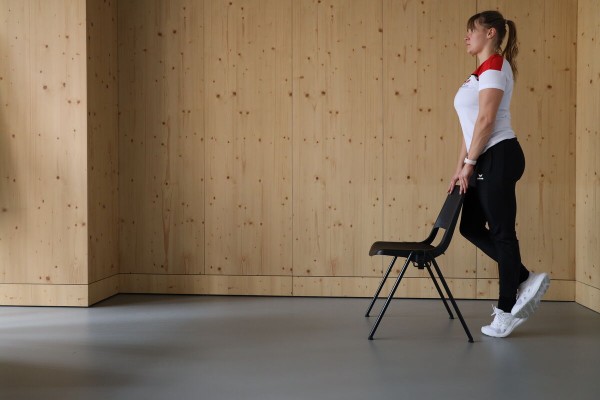
Stand on one leg (left) behind a chair, the free leg can be placed with the instep of the foot on the calf of the supporting leg. Raise the heel of the free leg (left) to stand on the tip of the foot and lower it back to the starting position (if necessary without putting the heel down completely). To make it easier to keep your balance, hold on to the back of the chair with your hands.
Attention:
Maintain an upright position (body tension).
1 (office) chair
Raising and lowering the heel while standing on one leg (right) ► calf raise
Power
Individual work


Stand upright on one leg (on the right leg), arms crossed behind the body, raise the heel (standing on the tip of the foot) and lower without fully setting down.
Attention:
Maintain an upright position (body tension), aim for a fixed point with your eyes for balance.
Lighten:
Support yourself on a wall or with a partner to keep your balance.
Harden:
Hold additional weight (on your shoulders/in front of your chest or in your hands).
1 weight vest/weight disc/barbell/sandbag/fighting backpack/2 dumbbells ► Make the exercise more difficult (additional weight)
Raising and lowering the heel while standing on one leg (right) ► calf raise
Power
Individual work

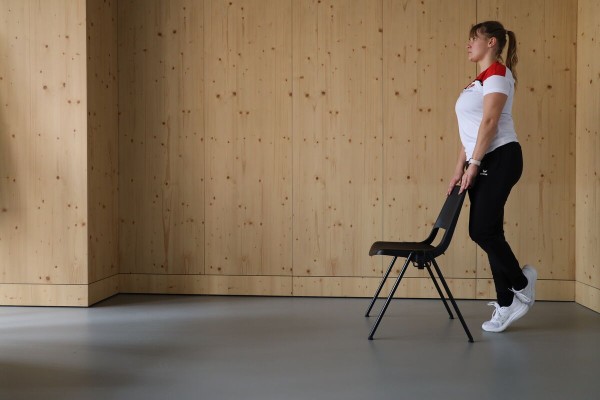
Stand on one leg (right) behind a chair, the free leg can be placed with the instep of the foot on the calf of the supporting leg. Raise the heel of the free leg (right) to stand on the tip of the foot and lower it back to the starting position (if necessary without putting the heel down completely). To make it easier to keep your balance, hold on to the back of the chair with your hands.
Attention:
Maintain an upright position (body tension).
1 (office) chair
Raising and lowering the heels while standing ► calf raise
Power
Individual work

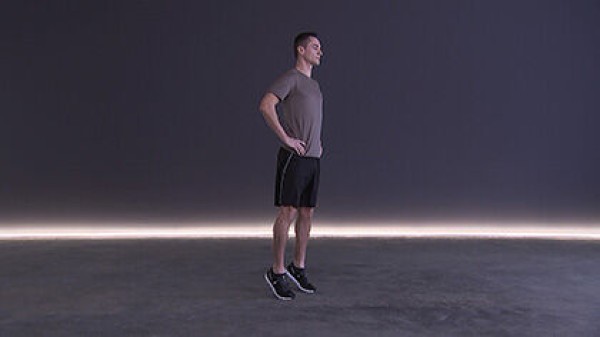
Stand upright with your feet shoulder-width apart, your arms on your hips or folded behind your body, raise and lower your heels without fully taking them off the floor.
Attention:
Maintain an upright position (body tension), aim for a fixed point with your eyes for balance.
Lighten:
Support yourself on a wall or with a partner to keep your balance.
Harden:
Hold additional weight (on your shoulders/in front of your chest or in your hands).
Variant:
Stand on a raised surface.
1 weight vest/weight disc/barbell/sandbag/fighting backpack/2 dumbbells ► Make the exercise more difficult (additional weight)
Raising and lowering the heels while standing ► calf raise
Power
Individual work
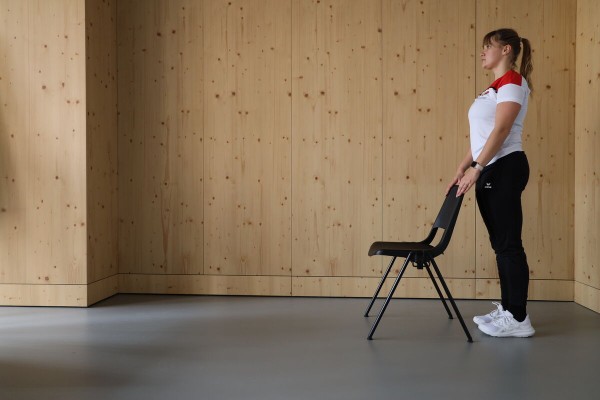
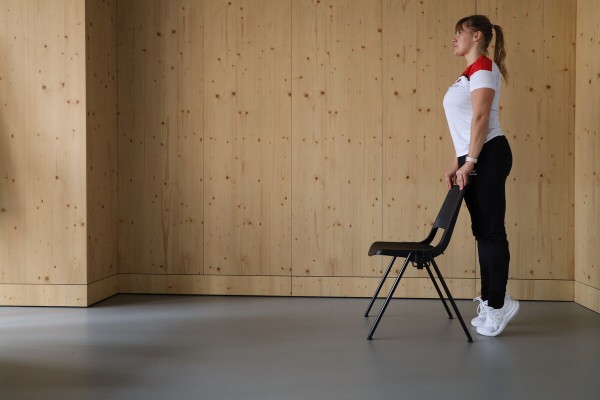
Stand upright shoulder-width apart behind a chair, raise your heels to stand on the tips of your feet and lower back to the starting position (if necessary, without putting your heels down completely). To make it easier to keep your balance, hold on to the back of the chair with your hands.
Attention:
Maintain an upright position (body tension).
1 (office) chair
Raising and lowering the shoulders on a slope ► scapular pull up
Power
Individual work


Hold on to the horizontal bar in a hanging position (full body extension, arms stretched out overhead in a high position - passive hang) (the position can be assumed with the help of a bench or a chair), the hands grasp the bar with an overhand grip (palms facing backwards), the arms are positioned shoulder-width apart. Switch from the passive to the active hang by pulling the shoulders downwards while the elbows remain stable. Then keep alternating between the active and passive slope. After the exercise, slowly place your feet back on the chair or bench before releasing your hands from the bar or dropping to the floor to stand.
Attention:
Keep your upper body still (no swinging; tense your core muscles); arms are fully extended (no bending of the elbows); during the passive hang, do not deliberately lift your chest upwards, but try to work only in the vertical plane by pulling your shoulders downwards.
Lighten:
Do the exercise for a shorter period of time; use the elastic band as support (place one or both feet on the band).
Harden:
Additional weight.
Variant I:
Knee bent.
Variant II:
Grab the bar with a neutral grip or underhand grip (palm facing your face).
1 horizontal bar
1 elasticated rubber band ► Make the exercise easier (support)
2 weight cuffs/1 weight waistcoat ► Make the exercise more difficult (additional weight)
Raising and lowering the shoulders while standing ► shoulder shrug
Power
Individual work
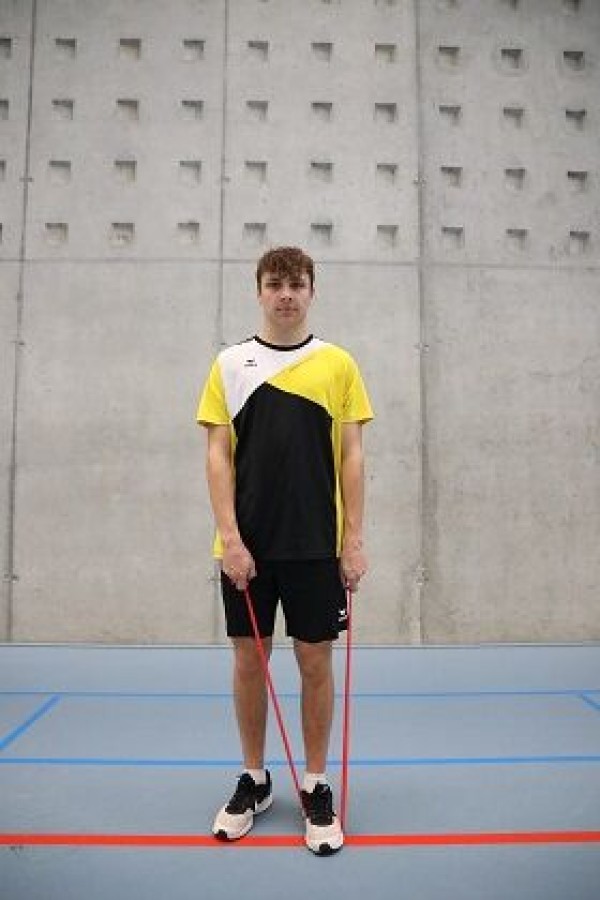
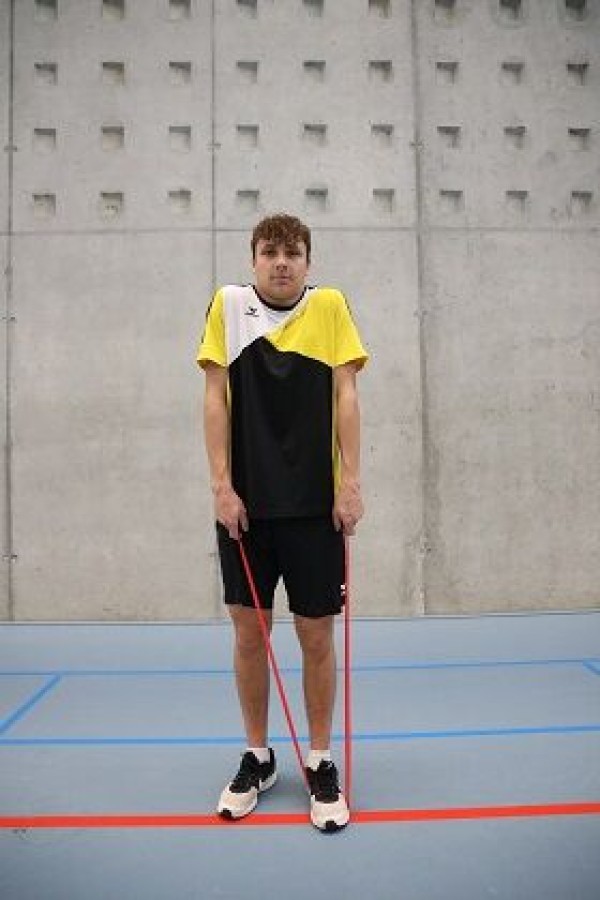
Stand upright, shoulder-width apart in the centre of the elastic band, let your arms and shoulders hang down, grasp one end of the already stretched band with your hands, pull your shoulders up as far as possible towards your ears with your arms outstretched and return to the starting position.
Attention:
Do not arch your back (tighten your stomach).
Lighten:
Select a rubber band with less resistance.
Harden:
Select a rubber band with greater resistance.
1 elasticated rubber band
Raising and lowering the shoulders while standing ► shoulder shrug
Power
Individual work


Standing upright with your arms hanging at your sides, simultaneously pull the weights up towards your ears and lower them back down to the starting position. The movement only takes place from the shoulders.
Starting position:
- Stand with shoulders wide apart (looking straight ahead)
- Tense torso
- Arms hanging beside the body, holding dumbbells in a neutral grip
Finishing position:
- Shoulders pulled up towards the ears
Variant:
The exercise can also be performed with a barbell. The barbell is held with an overhand grip in front of the thighs and the movement is performed as described above.
2 dumbbells/kettlebells
1 barbell ► Variation of the exercise